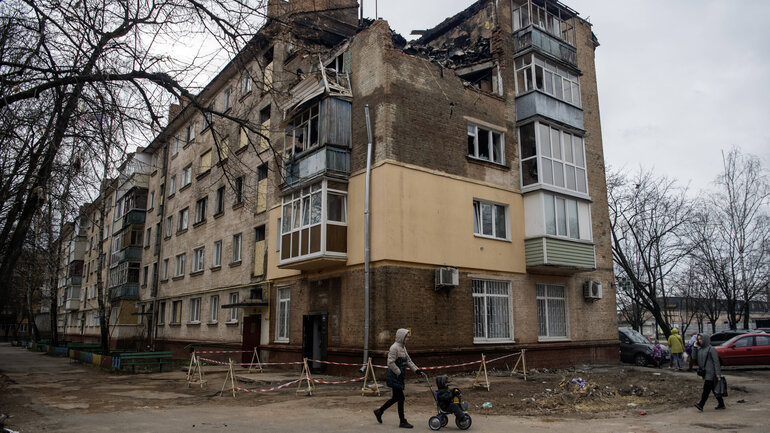Ceasefire Lines – Everyday Life, Security and Spaces of Engagement in War
A ceasefire in the war against Ukraine would not only mark a pause in the hostilities: it would directly affect the lives of people at the front line – and open up opportunities for peace talks. A lasting peace will only be successful if local communities’ needs are considered.

There is often talk of a ceasefire in the war between Russia and Ukraine. Meetings are held, phone calls placed – part of the various political attempts, since the war began, to at least temporarily halt the war and pave the way for peace negotiations. Ceasefires and ceasefire lines are the outcome of the war’s progression; they reflect its political and military rationale and are negotiated accordingly. But what is life like for the civilian population in wartime and during a ceasefire?
What is a ceasefire?
According to the 1907 Hague Convention respecting the Laws and Customs of War on Land, a ceasefire (armistice) “suspends military operations by mutual agreement between the belligerent parties”. It may be general or apply solely to specific troop units (naval, territorial or airborne).
Ceasefire negotiations are generally conducted by male delegates from the parties’ foreign and defence ministries and armed forces and by other high-ranking government officials. The talks take place on neutral territory – for example, in Minsk (Belarus) in 2014 and 2015 or Istanbul (Turkey) in June 2025. The presidents of the warring countries or leaders of countries deemed to be neutral also play a key role: they mediate between the parties or facilitate the talks in some other way.
The negotiations focus on the location and duration of a ceasefire, the withdrawal of troops, the recognition or cession of territories, issues around independence, or security guarantees. The results are noted down in memoranda and agendas – as at the latest negotiations between Ukraine and Russia in Istanbul. These documents address the root causes of conflict that have led to war.
The front line and a ceasefire
In the war in Eastern Ukraine, ongoing since 2014, the two Minsk agreements established a ceasefire line along what was the front line at the time of the negotiations. However, fierce fighting continued and so the front line was in a constant state of flux, with the military having a strong presence in and control of the area. Here, the social and technical infrastructure was in ruins, the housing stock damaged, the territory mined, the natural environment impacted and residential areas abandoned or only partially inhabited. The line cut through densely populated areas that had previously been characterised by a high degree of social, economic, infrastructural and cultural integration. A ceasefire would likely be based on the current front line, which runs through the regions of Zaporizhzhia and Kherson in the south, round the Donetsk and Luhansk regions in the east, and through the Sumy and Kharkiv regions in the north-east.
Space and society in war
The lives of the people living near or along the front lines are impacted by the war – irrespective of age, gender or social status. Apart from the constant threat to life, these people have numerous challenges to contend with. Education is hard to access – for children, youths, students and teachers alike. Lessons are often interrupted by air strikes or take place in cellars, bunks or online under arduous conditions. A further factor in the areas under occupation is that Russia sets the curricula – a targeted attempt to influence identity formation.
Adults with families lack incomes and secure employment – many businesses have been destroyed or have relocated elsewhere. There is also a lack of food and basic supplies. Communities near the front lines are therefore permanently dependent on aid deliveries, which are more difficult to access in rural areas than in cities. The healthcare system has been partially destroyed; staff have fled and medicines are in short supply.
Many people in the war zone have missing loved ones or are searching for people who are now stranded on one side or the other of the front line or living in occupied or annexed areas. They wish to be reunited with their children, parents or grandchildren or need documents and property that are located beyond the front line. In order to make this possible, some local women have been self-organising in cross-border civil society initiatives for many years. They maintain contact across the front line and seek shared solutions to problems. This has given rise to other local initiatives that deal with the practical impacts of war and improve the situation for local people through joint action.
The electricity and water supply systems have also been destroyed, which makes living, working and provisioning the region more difficult. Infrastructure that supplied people on both sides of the front line has been destroyed and is in need of repair, which requires a particularly high level of commitment and depends on networks across the front line. In some instances, however, this also creates opportunities to maintain links at the local level.
Negotiations and human security
Communities and individuals who are directly affected by the war develop remarkable strategies to cope with the situation on the ground. They reveal to what extent people have agency and opportunities despite the challenging conditions – but also where their limits lie.
Understanding how communities cope with life in war, particularly across conflict lines, is also relevant for ceasefire and peace negotiations. These communities are creating conditions, opportunities and contexts for the practical implementation of a ceasefire that would be agreed around a negotiating table far away. The needs and experiences of ordinary people also play a key role in ensuring a lasting peace.
PD Dr Sabine von Löwis is a researcher at ZOiS and head of the ‘Conflict Dynamics and Border Regions’ research cluster.
Noah Harris is a research assistant in the ‘Conflict Dynamics and Border Regions’ research cluster.